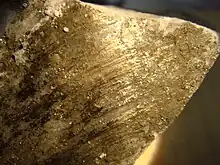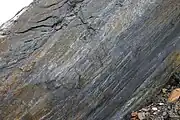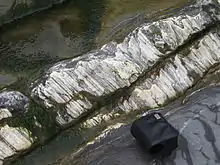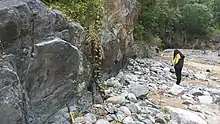
In geology, a slickenside is a smoothly polished surface caused by frictional movement between rocks along a fault. This surface is typically striated with linear features, called slickenlines, in the direction of movement.[1]
Geometry of slickensides
A slickenside can occur as a single surface at a fault between two hard surfaces. Alternatively, the gouge between the fault surfaces may contain many anastamosing slip surfaces that host slickensides.[2] These slip surfaces are on the order of 100 micrometers thick,[3] and the size of the grains that constitute the surface are ultra-fine (0.01-1 micrometers in diameter).[4] These grains are unlike typical grains of fault rock in that they have irregular grain boundaries and few crystal lattice defects (termed dislocations).[4]
Slickensides have conspicuous shapes that can be used to determine the direction of movement along the fault. [5] Straight slickenlines indicate linear-translational fault motion. They are parallel to the direction of fault motion and serve as a kinematic indicator.[6] Curved slickenlines have recently been studied for their potential to preserve the direction of earthquake rupture propagation. [7]
Surface Roughness
Slickenside formation results in unique roughness on a slip surface. Fault surface roughness (or topography) is characterized by the aspect ratio of asperity height to scale of observation, and this roughness is a key parameter in the study of fault slip. [8] In general, a fault surface appears rougher at smaller scales (i.e. rough and bumpy at approximately millimetre scales and smaller, and increasingly smooth with larger fields of view).[9] This smoothing with larger observation scales is more pronounced in the slip-parallel direction than the slip-perpendicular direction and is commonly a result of slickenside formation.
Mechanisms to create slickensides

The unique geometry of a slickenside can be created in a variety of ways,[10] but the precise mechanisms that create them is not well understood. The grinding between two rocks produces granular material, and there is a change in the behaviour of wear material when the particle size is reduced to nanometers.[11] When the particle size is reduced so dramatically that the surface becomes shiny, it can be characterized as a fault mirror.[11]
A fault mirror may also be the result of fluid being present at the fault surface during slip.[12] Once slip has stopped, this fluid solidifies as a silica gel, which appears shiny and hosts slickenlines.
Asperity plowing
An asperity on a fault surface is a bump or point with higher relief than the area around it. The asperity, when pressed into the opposing rock surface and then moved, digs into the opposing rock, forming troughs, grooves, and scratches.[10] Asperity plowing is thus a result of permanent deformation in the brittle regime at a small scale.[13]
Debris streaking
When an asperity plows into the opposing rock, it wears itself and the opposing rock down and produces fine debris. This debris, or wear product, accumulates both in front of and behind the asperity in a long, elongated shape. If the asperity is relatively hard, the debris will accumulate in front of the asperity. If the asperity is relatively soft, the debris will trail behind. This debris hardens over time and is preserved as a form of slickenline.[10]
Erosional sheltering
Some rocks may contain particles that are harder than the rest of the rock. When these rocks are worn, the harder particles will resist wear more than the softer rock, the rock on the lee side of the hard particle will be protected from wear. This creates a tail that starts abruptly as a crag where the hard particle was located and is elongated parallel to the direction of movement down-slip from the particle.[10]

Fibre growth
The fault plane may be coated by mineral fibres that grew in during the fault movement, known as slickenfibres. Due to irregularities in the fault plane, exposed slickenfibres typically have a stepped appearance that can be used to determine the sense of movement across the fault.

Slickenfibres are secondary minerals that make up the slickensides rather than the rock itself. Slickenfibres form in areas where the rock slowly creep past one another rather than sliding suddenly as a result of an earthquake.[14] Unlike slickenlines, which give two possibilities for slip direction, slickenfibres preserve the true slip direction.[14]
Implications
Slickensides provide useful insight into earthquake processes. Calcite slickenfibres have recently been used to constrain the depth of aseismic creep in the Zagros Mountains as well as the orientation of stress acting on the fault.[15] It has also been suggested that when multiple slickenfibre or slickensteps orientations are present, it can indicate that the ongoing shear is not strain softening so slip does not have a constant direction. [11]
In addition to the direction of slip, slickenlines have also been used to constrain the timing of fault slip.[16] They also preserve any complexity in the geometry of the earthquake rupture.[17]
Other types of slickensides
Slickensides in soils
In pedology, the study of soils in their natural environments, a slickenside is a surface of the cracks produced in soils containing a high proportion of swelling clays. Slickensides are a type of cutan. In the Australian Soil Classification, slickensides, along with lenticular structural aggregates, are an indicator of a vertisol.[18]
Slickensides on the Moon
On the Moon, a boulder with slickensides, discovered in a debris-strewn small crater at Station 9 near Rima Hadley, was photographed during a moonwalk by the crew of Apollo 15.[19][20][21]
Gallery


 Slickensides on a fault plane, south wall of Bear Valley Strip Mine. Lens cap 5.8cm wide.
Slickensides on a fault plane, south wall of Bear Valley Strip Mine. Lens cap 5.8cm wide.
 Slickensides on a fault plane in Corona Heights Park, San Francisco
Slickensides on a fault plane in Corona Heights Park, San Francisco Greenschist with slickensides in Itogon, Benguet, Philippines.
Greenschist with slickensides in Itogon, Benguet, Philippines.
Notes
- ↑ Tjia, H. D. "Slickensides and fault movements." Geological Society of America Bulletin 75.7 (1964): 683-686.
- ↑ Scholz, Christopher H. "The Mechanics of Earthquakes and Faulting." 3rd Edition. (2019): 128.
- ↑ Sagy, Amir, and Emily E. Brodsky. "Geometric and rheological asperities in an exposed fault zone." Journal of Geophysical Research: Solid Earth 114.B2 (2009).
- 1 2 Power, William L., and Terry E. Tullis. "The relationship between slickenside surfaces in fine-grained quartz and the seismic cycle." Journal of Structural Geology 11.7 (1989): 879-893.
- ↑ Doblas, Miguel. "Slickenside kinematic indicators." Tectonophysics 295.1-2 (1998): 187-197.
- ↑ Nibir Mandal and Chandan Chakraborty (1989) Fault motion and curved slickenlines: a theoretical analysis, Journal of Structural Geology
- ↑ Kearse, J., Kaneko, Y., Little, T., and Van Dissen, R., 2019, Curved slickenlines preserve direction of rupture propagation: Geology, https://doi.org/10.1130/G46563.1
- ↑ Emily E. Brodsky, James D. Kirkpatrick, Thibault Candela; Constraints from fault roughness on the scale-dependent strength of rocks. Geology 2016;; 44 (1): 19–22. doi: https://doi.org/10.1130/G37206.1
- ↑ Candela, T., Renard, F., Klinger, Y., Mair, K., Schmittbuhl, J., and Brodsky, E. E. (2012), Roughness of fault surfaces over nine decades of length scales, J. Geophys. Res., 117, B08409, doi:10.1029/2011JB009041.
- 1 2 3 4 Means, W. D. "A newly recognized type of slickenside striation." Journal of Structural geology 9.5-6 (1987): 585-590.
- 1 2 3 Toy, V. G., A. Niemeijer, F. Renard, L. Morales, and R. Wirth (2017), Striation and slickenline development on quartz fault surfaces at crustal conditions: Origin and effect on friction, J. Geophys. Res. Solid Earth, 122, 3497–3512, doi:10.1002/2016JB013498
- ↑ Kirkpatrick, J. D., et al. "Silica gel formation during fault slip: Evidence from the rock record." Geology 41.9 (2013): 1015-1018.
- ↑ Kirkpatrick, J. D., & Brodsky, E. E. (2014, October 22). Slickenline orientations as a record of Fault Rock Rheology. Earth and Planetary Science Letters. Retrieved November 3, 2022, from https://www.sciencedirect.com/science/article/pii/S0012821X14006037
- 1 2 Ishii, Eiichi. (2017). Estimation of the highest potential transmissivity of discrete shear fractures using the ductility index. International Journal of Rock Mechanics and Mining Sciences. 100. 10-22. 10.1016/j.ijrmms.2017.10.017.
- ↑ Sarkarinejad, Khalil, Maryam Mottahedi, and Maryam Nori. "Aseismic slip on the active Sabz-Pushan and Sepidar thrusts, Iran: microstructural and kinematics evidence of the slickenline fibre creep." International Journal of Earth Sciences 110.8 (2021): 2831-2848.
- ↑ Norris, D. K. "Slickenlines and the kinematics of the Crowsnest Deflection in the Southern Rocky Mountains of Canada." Journal of Structural Geology 23.6-7 (2001): 1089-1102.
- ↑ Macklin, Clarrie, Yoshihiro Kaneko, and Jesse Kearse. "Coseismic slickenlines record the emergence of multiple rupture fronts during a surface-breaking earthquake." Tectonophysics 808 (2021): 228834.
- ↑ Isbell, Raymond F. (1996). The Australian Soil Classification (1st ed.). Collingwood, Victoria: CSIRO Publishing. ISBN 0-643-05813-3.
- ↑ https://www.lpi.usra.edu/resources/apollo/catalog/70mm/magazine/?82 Apollo Image Atlas (Lunar and Planetary Institute), 70 mm Hasselblad Image Catalog, Apollo 15 photographs AS15-82-11101, AS15-82-11102, AS15-82-11103 and AS15-82-11104
- ↑ https://www.hq.nasa.gov/alsj/a15/a15.sta9.html Apollo 15 Lunar Surface Journal – Instant Rock at Station 9
- ↑ https://history.nasa.gov/alsj/a15/A15SampleCat_1.pdf Catalog of Apollo 15 Rocks – Part 1. 15015-15299
References
- Allaby, A. and Allaby, M. (Eds). 1990. The Concise Oxford Dictionary of Earth Sciences. New York, USA: Oxford University Press.
- McDonald, R. C. et al. 1990. The Australian Soil and Land Survey Field Handbook, 2nd Ed. Melbourne, Australia: Inkata Press.
- Microtectonics, by C.W.Passchier and R.A.J.Trouw, 2nd rev. and enlarged ed., 2005, XVI, 366 p., 322 illus., with CD
External links
- . Encyclopedia Americana. 1920.